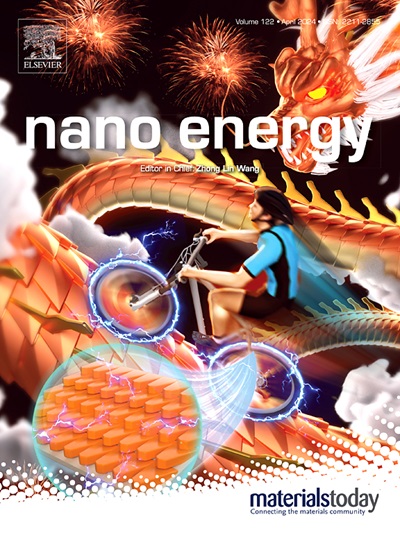用于自供电能量收集和实时语音到文本转换的抗噪声可穿戴压电纳米发电机
IF 17.1
1区 材料科学
Q1 CHEMISTRY, PHYSICAL
引用次数: 0
摘要
由于COVID-19、埃博拉和SARS等传染病的增加,医疗和工业环境中的有效沟通越来越困难。防护装备和口罩进一步阻碍了医务人员的清晰沟通。由于环境噪声和物理障碍物,传统的麦克风在这些环境中经常失效。为了解决这些挑战,我们开发了一种自供电、可贴肤的声学压电纳米发电机(FPENG)。该器件采用钛酸钡(BaTiO3)修饰的功能化多壁碳纳米管(f-MWCNTs)制成,集成到聚二甲基硅氧烷(PDMS)基体内的mxene基杂化复合材料中。FPENG专为喉部直接连接而设计,即使在嘴部被覆盖或处于嘈杂环境中,也能检测机械振动并清晰捕获语音信号。利用MXene、f-MWCNTs和BaTiO3的协同特性,其峰值输出电压达到~1.2 V,优于其他fengs。作为一种声学传感器,它可以准确地记录音乐,并且对声音频率具有很高的灵敏度。当连接到声带时,它在嘈杂环境和防毒面具下的性能优于商用麦克风。此外,它支持实时语音到文本转换和咳嗽类型识别,支持其在高级健康监测方面的潜力。本文章由计算机程序翻译,如有差异,请以英文原文为准。

Noise-resistant wearable piezoelectric nanogenerator for self-powered energy harvesting and real-time speech-to-text conversion in healthcare monitoring
Effective communication in medical and industrial settings is increasingly difficult due to the rise of infectious diseases such as COVID-19, Ebola, and SARS. Protective gear and masks further hinder clear communication for medical personnel. Conventional microphones often fail in these environments due to ambient noise and physical obstructions. To address these challenges, we developed a flexible, self-powered, skin-attachable acoustic piezoelectric nanogenerator (FPENG). The device is fabricated using functionalized multi-walled carbon nanotubes (f-MWCNTs) decorated with barium titanate (BaTiO3), integrated into an MXene-based hybrid composite within a polydimethylsiloxane (PDMS) matrix. Designed for direct throat attachment, the FPENG detects mechanical vibrations and captures voice signals clearly, even when the mouth is covered or in noisy surroundings. Leveraging the synergistic properties of MXene, f-MWCNTs, and BaTiO3, it achieves a peak output voltage of ∼1.2 V, outperforming other FPENGs. As an acoustic sensor, it accurately records music and demonstrates high sensitivity to voice frequencies. When attached to the vocal cords, it surpasses commercial microphones in loud environments and with gas masks. Moreover, it enables real-time speech-to-text conversion and cough-type identification, supporting its potential in advanced healthcare monitoring.
求助全文
通过发布文献求助,成功后即可免费获取论文全文。
去求助
来源期刊

Nano Energy
CHEMISTRY, PHYSICAL-NANOSCIENCE & NANOTECHNOLOGY
CiteScore
30.30
自引率
7.40%
发文量
1207
审稿时长
23 days
期刊介绍:
Nano Energy is a multidisciplinary, rapid-publication forum of original peer-reviewed contributions on the science and engineering of nanomaterials and nanodevices used in all forms of energy harvesting, conversion, storage, utilization and policy. Through its mixture of articles, reviews, communications, research news, and information on key developments, Nano Energy provides a comprehensive coverage of this exciting and dynamic field which joins nanoscience and nanotechnology with energy science. The journal is relevant to all those who are interested in nanomaterials solutions to the energy problem.
Nano Energy publishes original experimental and theoretical research on all aspects of energy-related research which utilizes nanomaterials and nanotechnology. Manuscripts of four types are considered: review articles which inform readers of the latest research and advances in energy science; rapid communications which feature exciting research breakthroughs in the field; full-length articles which report comprehensive research developments; and news and opinions which comment on topical issues or express views on the developments in related fields.
 求助内容:
求助内容: 应助结果提醒方式:
应助结果提醒方式:


